

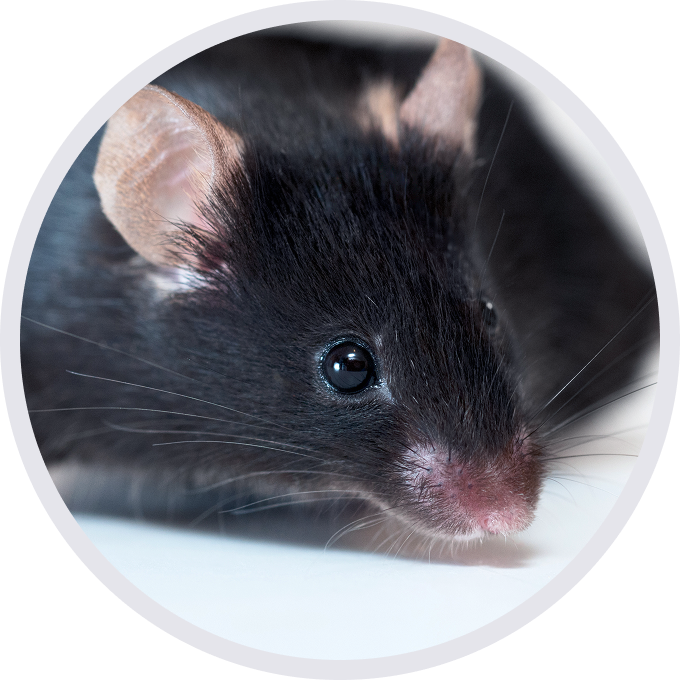
C57BL/6N-Tg(RP11-634C1)1Bcgen/Bcgen • 110858
| Product name | B-Tg(hLILRB2/hLILRB3) mice |
|---|---|
| Catalog number | 110858 |
| Strain name | C57BL/6N-Tg(RP11-634C1)1Bcgen/Bcgen |
| Strain background | C57BL/6N |
| NCBI gene ID | 10288,11025 |
| Aliases | LILRB2: ILT4, LIR2, CD85D, ILT-4, LIR-2, MIR10, MIR-10; LILRB3: HL9, ILT5, LIR3, PIRB, CD85A, ILT-5, LIR-3, PIR-B, LILRA6 |
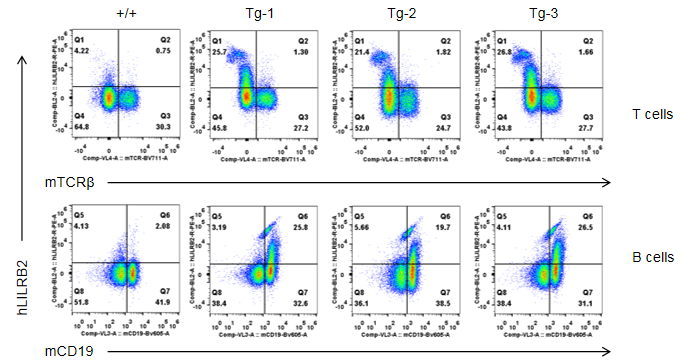
Strain specific LILRB2 expression analysis in transgenic B-Tg(hLILRB2-hLILRB3) mice by flow cytometry. T cells and B cells of blood were collected from wild-type (+/+) and transgenic B-Tg(hLILRB2-hLILRB3) mice (Tg), and analyzed by flow cytometry with species-specific anti-human LILRB2 antibody. Human LILRB2 was not detectable in T cells of B-Tg(hLILRB2-hLILRB3) mice but detectable in B cells.
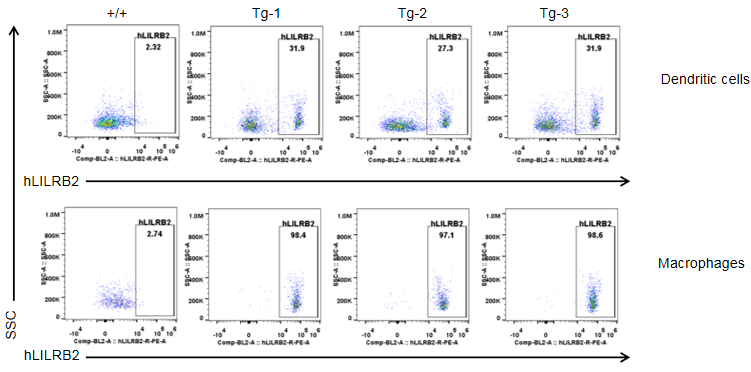
Strain specific LILRB2 expression analysis in transgenic B-Tg(hLILRB2-hLILRB3) mice by flow cytometry. Dendritic cells and macrophages of blood were collected from wild-type (+/+) and transgenic B-Tg(hLILRB2-hLILRB3) mice (Tg), and analyzed by flow cytometry with species-specific anti-human LILRB2 antibody. Human LILRB2 was both detectable in dendritic cells and macrophages from B-Tg(hLILRB2-hLILRB3) mice but not wild-type mice.
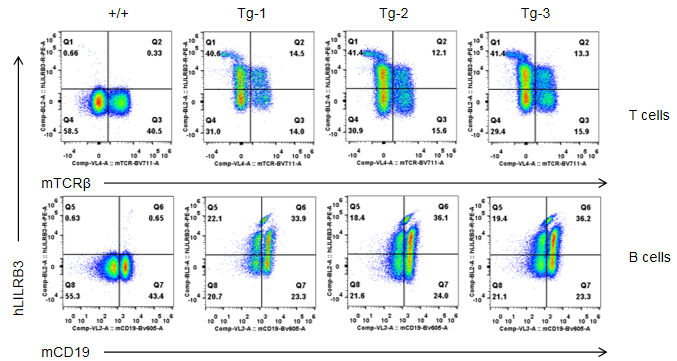
Strain specific LILRB3 expression analysis in transgenic B-Tg(hLILRB2-hLILRB3) mice by flow cytometry. T cells and B cells of blood were collected from wild-type (+/+) and transgenic B-Tg(hLILRB2-hLILRB3) mice (Tg), and analyzed by flow cytometry with species-specific anti-human LILRB3 antibody. Human LILRB3 was both detectable in T cells and B cells of B-Tg(hLILRB2-hLILRB3) mice but not in wild-type mice.
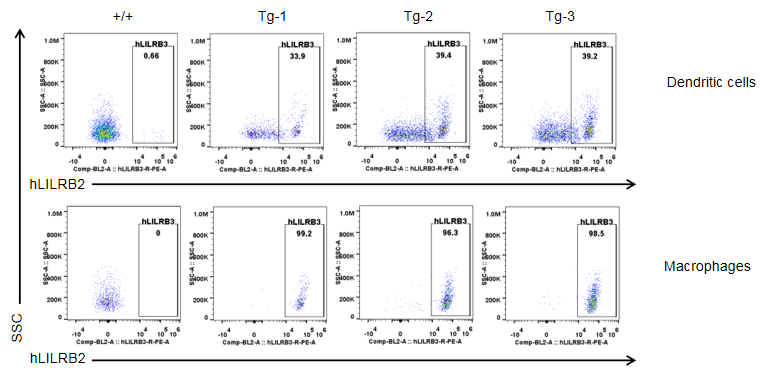
Strain specific LILRB3 expression analysis in transgenic B-Tg(hLILRB2-hLILRB3) mice by flow cytometry. Dendritic cells and macrophages of blood were collected from wild-type (+/+) and transgenic B-Tg(hLILRB2-hLILRB3) mice (Tg), and analyzed by flow cytometry with species-specific anti-human LILRB3 antibody. Human LILRB3 was both detectable in dendritic cells and macrophages from B-Tg(hLILRB2-hLILRB3) mice but not wild-type mice.
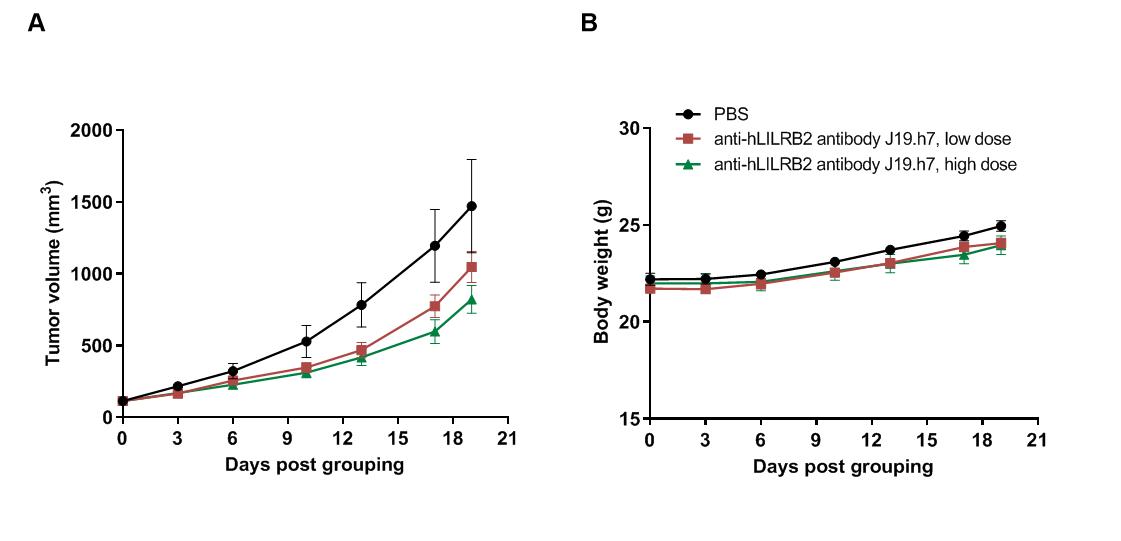
Antitumor activity of anti-human LILRB2 antibody in B-Tg(hLILRB2-hLILRB3) mice. (A) Anti-human LILRB2 antibody inhibited MC38 tumor growth in B-Tg(hLILRB2-hLILRB3) mice. Murine colon cancer MC38 cells were subcutaneously implanted into B-Tg(hLILRB2-hLILRB3) mice (female, 9 week-old, n=6). Mice were grouped when tumor volume reached approximately 100-150 mm3, and treated with anti-h LILRB2 antibody in panel A. (B) Body weight changes during treatment. As shown in panel A, J19.h7 (in-house) was efficacious in controlling tumor growth in B-Tg(hLILRB2-hLILRB3) mice, demonstrating they provide a powerful preclinical model for in vivo evaluation of anti-human LILRB2 antibodies. Values are expressed as mean ± SEM.